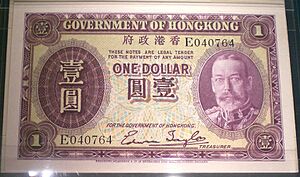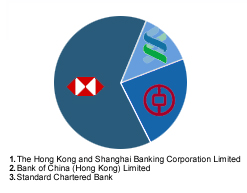Banknotes of the Hong Kong dollar facts for kids
Quick facts for kids Banknotes of the Hong Kong dollar |
||||
|---|---|---|---|---|
|
||||
| ISO 4217 Code | HKD | |||
| Official user(s) | ||||
| Unofficial user(s) | ||||
| Symbol | $ or HK$ | |||
| Banknotes | $10, $20, $50, $100, $150 (commemorative), $500, $1,000 | |||
| Printer | Issuing banks and authority:
Note printer: |
|||
Did you know that in Hong Kong, several different banks print the money you use every day? Most countries have only one central bank that prints all their banknotes. But in Hong Kong, the Hong Kong Monetary Authority (HKMA), which is like the government's money manager, allows three special commercial banks to print their own banknotes. The HKMA also prints some notes itself!
This system is quite unique, but not completely alone. For example, in the United Kingdom, several banks also print their own banknotes. In Hong Kong, you'll find banknotes in common use for $10, $20, $50, $100, $500, and $1,000.
Contents
How Hong Kong Banknotes Started
Early Money in Hong Kong (Before 1900)
Back in the 1860s, a few banks like the Oriental Bank Corporation and the Hong Kong and Shanghai Banking Corporation (HSBC) started printing their own money. They made notes for different amounts, like $1, $5, $10, and even $500. At first, the government didn't accept these notes for taxes, but people used them for buying and selling things. Over time, some of the smaller notes, like the $25 ones, stopped being used.
Changes in the 20th Century
A big change happened in 1935. A new law made banknotes of $5 and higher, printed by three main banks, officially "legal tender." This means they had to be accepted everywhere. The government also started printing $1 notes. During World War II, it was hard to get coins to Hong Kong, so the government even printed small notes for 1, 5, and 10 cents!
After the war, things went back to normal. The government printed small notes (cents and $1), and the three main banks printed larger notes ($5 to $500). In 1960, $1 notes were replaced by coins. Later, in 1975, $5 notes were also replaced by coins.
New, larger notes were introduced too, like the $1,000 note in 1977. In 1985, the $20 note appeared. By 1993, a $10 coin was made, and banks stopped printing $10 notes for a while. In 1994, another bank, the Bank of China, was allowed to print notes. The 1-cent note stopped being legal money in 1995.
Hong Kong Banknotes in the 21st Century
Around 2002, the government tried to replace the $10 banknotes with coins. But people really liked the $10 notes! So, the Hong Kong Monetary Authority (HKMA) started printing its own $10 notes. These were first made of paper, but since 2007, they've been printed on a special plastic material called polymer.
Older green $10 notes from commercial banks are still valid, but they are slowly being taken out of circulation. People often save them for special occasions like lai see during Chinese New Year.
Who Prints Hong Kong Money?
Banknotes circulated by the three different note issuers, 2020 The Hongkong and Shanghai Banking Corporation (56%) Bank of China (Hong Kong) (33.90%) Standard Chartered Hong Kong (10.1%)
The Hong Kong Monetary Authority (HKMA) gives permission to three commercial banks to print banknotes. These are:
- The Hongkong and Shanghai Banking Corporation Limited (HSBC)
- Standard Chartered Bank (Hong Kong) Limited
- Bank of China (Hong Kong) Limited
These banks must follow special rules. For example, they have to keep a certain amount of money in a special government fund for every banknote they print. This helps keep the Hong Kong dollar stable. The banknotes printed by these three banks are made right in Hong Kong by a company called Hong Kong Note Printing Limited.
How Banknotes Are Printed
In 1996, the Hong Kong government, through the HKMA, bought the banknote printing factory in Tai Po. This factory is now called HKNPL. This means the government is directly involved in making Hong Kong's money. It also owns most of the company, with some shares owned by a Chinese state-owned company and the three note-issuing banks.
Since 2007, the factory has been able to print the $10 banknotes on a special plastic material called polymer, which makes them more durable.
Banknotes You See Today
The HKMA prints the $10 note. The other three banks print notes for $20 (blue), $50 (green), $100 (red), $500 (brown), and $1,000 (gold).
2003 Banknote Series
The 2003 series of banknotes features famous Hong Kong landmarks or symbols.
- HSBC notes show places like Victoria Peak and the Hong Kong International Airport. They all feature the famous HSBC lions.
- Bank of China notes show landmarks like the Peak Tower and the Hong Kong Convention and Exhibition Centre. They feature the Bank of China Tower.
- Standard Chartered notes show historical pictures of Hong Kong from different time periods. They feature mythical Chinese creatures like the Chiwen and Qilin.
- The Government's $10 notes have a geometric design and a horse symbol.
2010 Banknote Series
The 2010 series focuses on different themes.
- HSBC notes celebrate traditional Chinese festivals like the Mid-Autumn Festival and Lunar New Year. They still feature the HSBC lion and building.
- Bank of China notes show beautiful natural landscapes and famous spots in Hong Kong, such as Repulse Bay and Lion Rock. They feature the Bank of China Tower.
- Standard Chartered notes combine heritage with technology. For example, the $20 note shows an Abacus and binary code. They feature mythical Chinese creatures.
2018 Banknote Series
The newest series, from 2018, has common themes across all three banks for each value.
- The $20 notes from all banks feature Tea Culture.
- The $50 notes show Butterfly and Flowers.
- The $100 notes highlight Cantonese Opera.
- The $500 notes feature Hexagonal Rock Columns from the Hong Kong UNESCO Global Geopark.
- The $1,000 notes show different views of Hong Kong as a financial city.
Each bank's notes still feature their own building or symbol.
Special Commemorative Banknotes
Sometimes, banks in Hong Kong print special banknotes to celebrate important events, like their anniversaries. These are often sold to collectors and are not usually used for everyday shopping, even though they are legal money.
- In 2009, Standard Chartered Bank made a unique $150 banknote for its 150th anniversary.
- In 2012, Bank of China issued a $100 note to celebrate its 100th anniversary.
- In 2015, Hongkong and Shanghai Banking Corporation (HSBC) also released a $150 banknote for its 150th anniversary.
- There have also been special $20 and $100 notes to celebrate the 2008 Summer Olympics and the 2022 Winter Olympics.
How to Spot a Real Banknote
Hong Kong banknotes have many special features to prevent people from making fake money. Here are some things to look for:
- Paper: The paper is made of 100% cotton and doesn't glow under UV light.
- Polymer: The $10 notes are made of plastic and have a clear window.
- Watermarks: Hold the note up to the light. You should see a clear picture, like a lion or a building, that's part of the paper itself. It looks the same from both sides.
- Security Thread: A thin metal strip is built into the paper. You can see it when you hold the note to the light.
- See-through Features: Special patterns on the front and back of the note line up perfectly when held up to the light.
- Raised Printing: The main pictures on the notes are printed in a way that makes them feel slightly raised to the touch. The lines are very sharp and clear.
It's against the law to copy or make fake Hong Kong banknotes. People who do this can face serious consequences.








